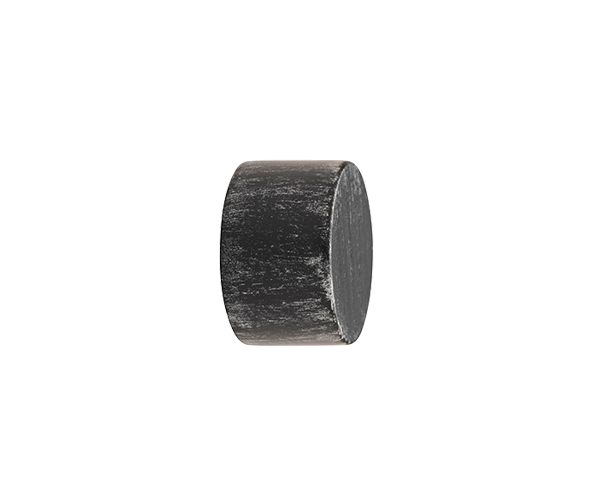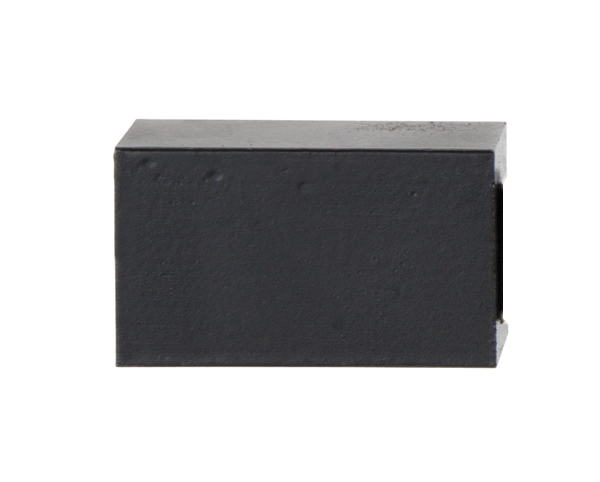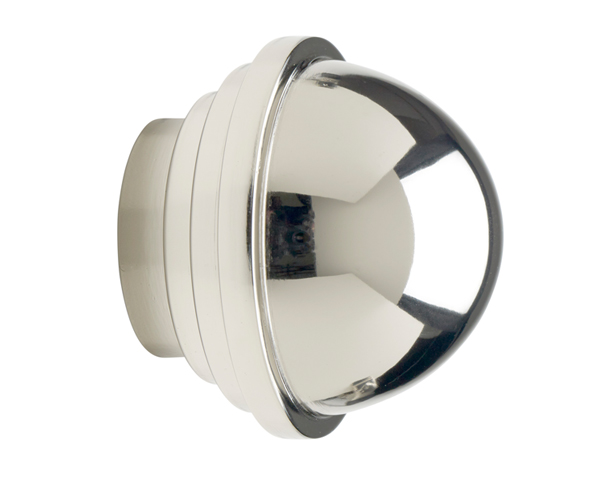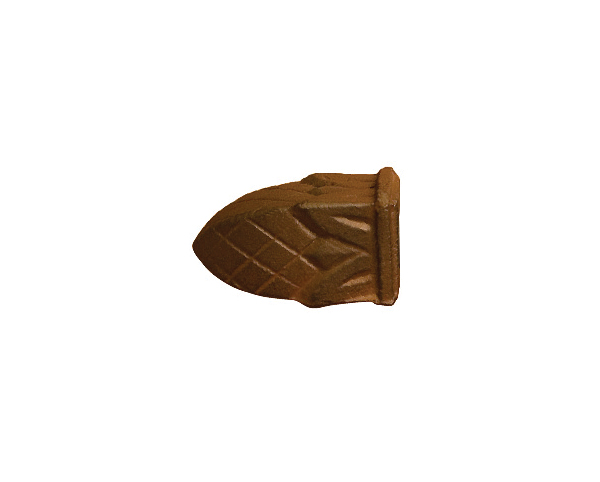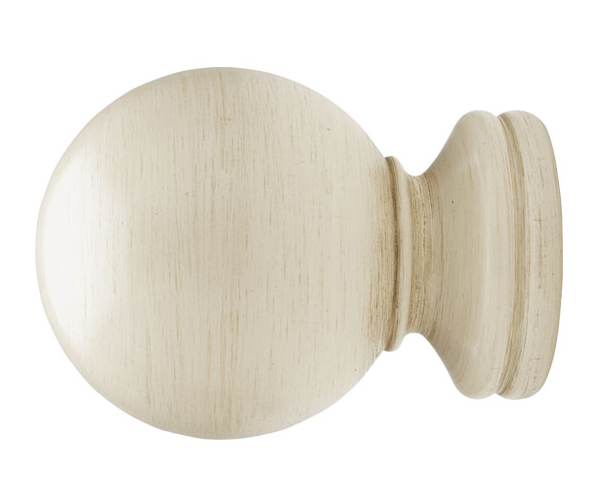Operable Curtain Rods Using Bypass Rings And Brackets
Written By: Product SupportPublished: 10-16-2023
- Download Article As PDF Booklet (1.6 MB)
- Bypass treatments require bypass rings, bypass brackets and poles purchased together from the same brand and collection to function
- Bypass rings and brackets are limited to metal style curtain rods
- Bypass can only be used with draperies that attach to poles with rings; grommet draperies, tab-top and rod pockets are not compatible
- While a bypass treatment can be constructed for any size window or opening; bypass functions best on spans under 192 inches for split draw, or 96 inches for one-way draw
- Tip-to-tip width of your drapery rod
- Overall weight of your drapery panels
- Number of rings your drapery panels will require

Bypass Treatments Allow Rings To Bypass Supports
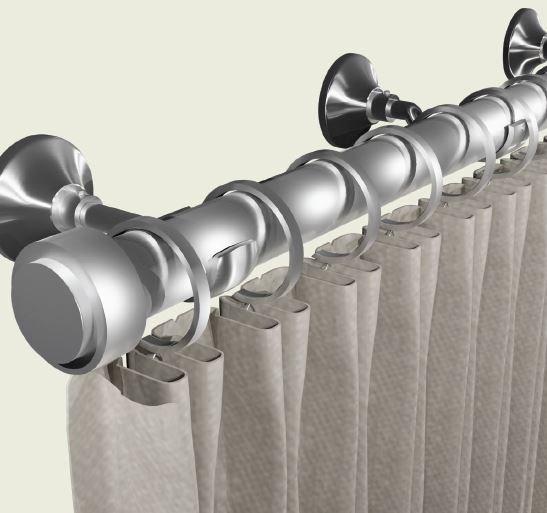
A good rule-of-thumb when determining the number of brackets and supports you'll need for your curtain rod is to plan for a bracket positioned every 3 ½ to 4 linear feet of pole. While there is a degree of wiggle-room in this formula; regardless of the pole type and diameter you choose, any pole treatment greater than four feet is going to need support in addition to the end brackets.
Split Draw Configuration
A window treatment with two panels, each moving from the ends to the center is a Split Draw. For Split Draw operation, the fabric meets in the middle and does not move past the center support bracket. If the distance between the end bracket and the middle bracket is greater than 48 inches, an intermediate support is required. The intermediate support must be a bypass bracket. The center support does not need to be a bypass bracket as the fabric never moves past the center point.
One-Way Draw Configuration
A window treatment with one panel moving from one side all the way to the opposite side is a One-Way Draw. If the distance between to two end brackets is greater than 48 inches, a center support is required. The center support must be a bypass bracket. The end bracket opposite the stack side must also be bypass for complete closure.
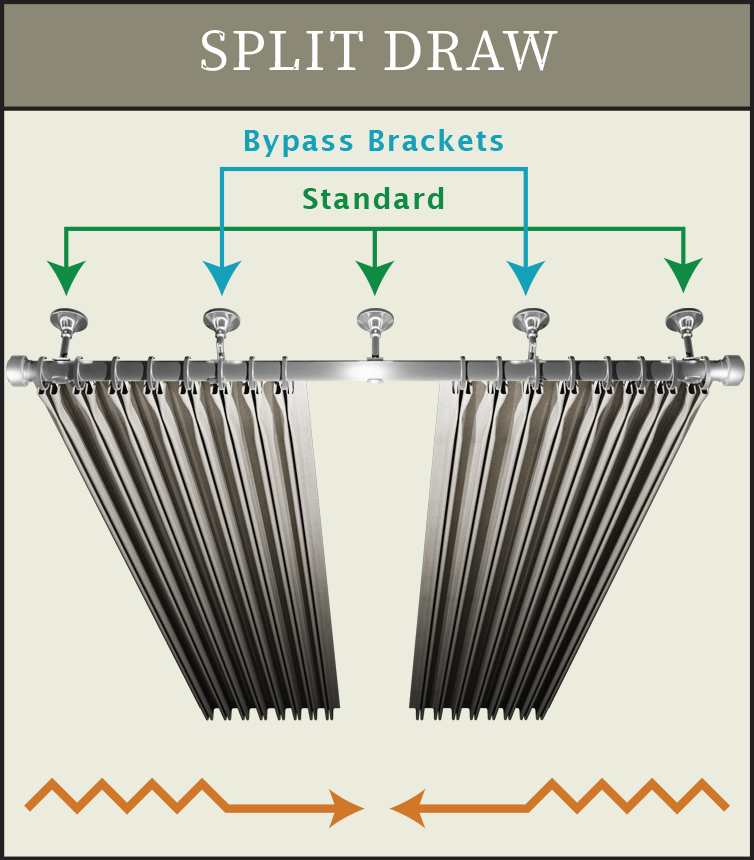


Assembling Bypass Treatments
Split Draw Configuration
For split draw treatments, three non-bypass brackets are required. Two for each end of your pole and one for the center. Intermediate brackets between the end brackets and center support must be bypass.
One-Way Draw Configuration
For one-way draw treatments, one non-bypass brackets is required on the stack side. All other brackets must be bypass.
Our 48-inch rule-of-thumb for bracket placement may not be appropriate for your treatment if your draperies are lined or interlined; or, if you're using either a petite pole diameter (one-inch or under) or an acrylic drapery rod.
The minimum distance between support brackets must be reduced to compensate for skinnier poles or heavy drapes. While the minimum distance between supports must be reduced based on your "best judgment"; 36 inches is a good starting point for most smaller poles and 24 inches should be used on acrylic poles.
Bypass Curtain Rod Rings
The number of bypass rings you will need will be determined by your drapery panels. For pleated draperies; you'll need a ring on each end of the panel and one for each pleat. For other drapery styles, a good rule-of-thumb is 3 to 4 rings per linear foot of pole.
While ring placement is a fairly straightforward determination for pleated draperies; you must use your "best judgment" when calculating the number of rings you'll need for all other styles. Rules-of-thumb are a great starting point, but they may over or under estimate the actual ring count you'll need to reach your desired fullness.
It is not necessary to use non-bypass rings on the portion of the fabric that will never move past the bypass bracket. And, in some cases, doing so will cause the drapery to hang unevenly or even pucker. Most drapery hardware makers offer bypass and non-bypass rings within a collection; but, sometimes, there may be differences between the two ring styles which can lead to unexpected results when used together. If you're hanging a bypass treatment, it's best to use bypass rings for the entire span.

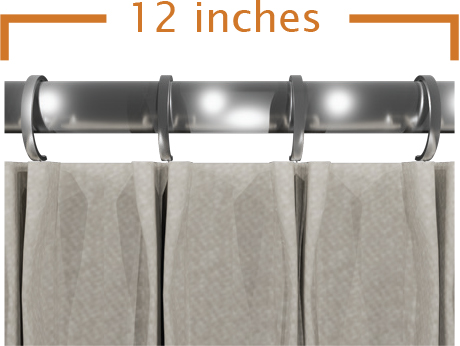
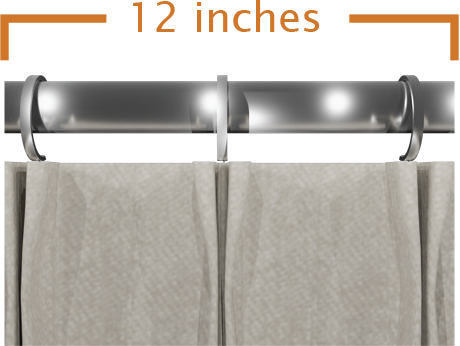
Operating A Bypass Treatment
The best way to operate a bypass treatment is with a drapery wand or baton that is permanently stitched into the header of the drapery fabric (not clipped to a ring).
Attach batons directly to the back of the drapery panel at the top. If you want your baton to be removable: stitch a ring (like a 5/8" brass ring) into the back of the header and clip the baton to the ring. Or, directly stitch the baton d-ring into the header.

While adding a baton makes it easier to open and close a bypass curtain treatment, you can "just use your hands". You simply have to be mindful that keeping the rings in relative alignment is necessary and you might need to "reach up there" and help a ring or two past a bracket from time to time. This is not indicative of a defect in your drapery hardware setup, it's just a natural response to rings being tugged a little downward by your hand.
Ring eyelets are not made to withstand the force of your tug when using a baton. Don't clip a baton to a ring or a rings eyelet. Repeated use will damage your ring and cause the rings to skew which may prevent them from crossing the bypass bracket.
Left & Right Movement With Horizontally Aligned Rings
Rings should stand up straight and remain in alignment when crossing a bypass bracket.
Misaligned Rings Can Get Caught On The Lip Of The Bypass Bracket & Prevent Movement
Lighter-weight draperies, or tugging downward, then left-or-right may lead to rings "flopping over" and not standing up straight.
Using bypass rings and brackets on a decorative pole treatment is a great way to overcome operation obstacles presented by intermediate supports. But, there are drawbacks and limitations.
Bypass Ring Alignment During Operation
Bypass rings must remain in relative horizontal alignment while crossing bypass brackets. Poor alignment can be caused by uneven "tugs" on the fabric as well as drapery weight. Heavier drapes help bypass rings keep their alignment straight; lighter curtains will allow the rings "more play" and increase alignment issues. Using a baton for operation will transfer the force of your tug to the top of the drapery panel and assist with ring alignment.
Heavier Draperies
Heavier draperies help keep your bypass rings aligned, but are more difficult to open and close. To operate any treatment with rings, you must "do the work yourself"; pushing or pulling your heavy drapery panels while keeping the rings in alignment may become cumbersome and difficult with heavy panels.
Large Spans
While there's no limit to the span size you can create using bypass supports, the more supports you add, the more difficult it will be to open and close your draperies.
It's suggested to limit one-way draw spans to 96 inches and split-draw spans to 192 inches. The overall goal would be to limit your span to a size that will require only one intermediate support for each panel.
You may create any size span you want. But, keep in mind as you add brackets, you may experience more difficulty when drawing your curtains.
Alternative To Using A Bypass Curtain Rods
If you need a bypass curtain rod treatment, your draperies are considered a "traversing treatment" – they will open and close. The best option for operable treatments is a Decorative Traverse Rod.
If you plan on drawing your draperies daily, a Decorative Traverse Rod will be a much easier solution than a bypass treatment. If you will only open and close your drapery once-in-awhile, bypass may be a better option.

Decorative Traverse Rods Look Just Like A Regular Pole Treatment, Complete With Finials or End Caps
You can keep the same look and style of a traditional pole treatment, but add the functionality of a traverse curtain rod when you use a Decorative Traverse Rod. Curtains attach with drapery pins to the carriers on the traverse rod.
Brackets can be positioned anywhere along the track and they will not interfere with the operation of the curtain in any way.
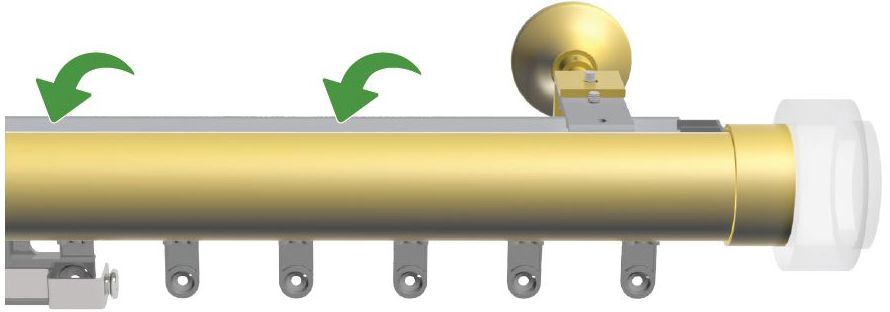
You can have the look of a decorative pole treatment without the hassle of "fiddling with" bypass rings.
Plus, with a cord draw Decorative Traverse Rod, the pulley mechanism "does the work for you" and makes opening and closing the draperies nearly effortless.
Expense-wise, you may find that a traverse rod may not increase the cost of your treatment as much as you'd think when compared to a bypass treatment.

